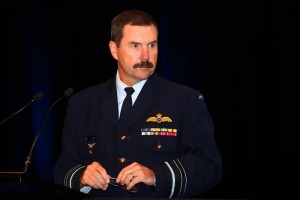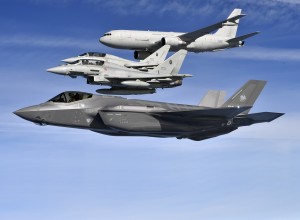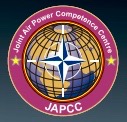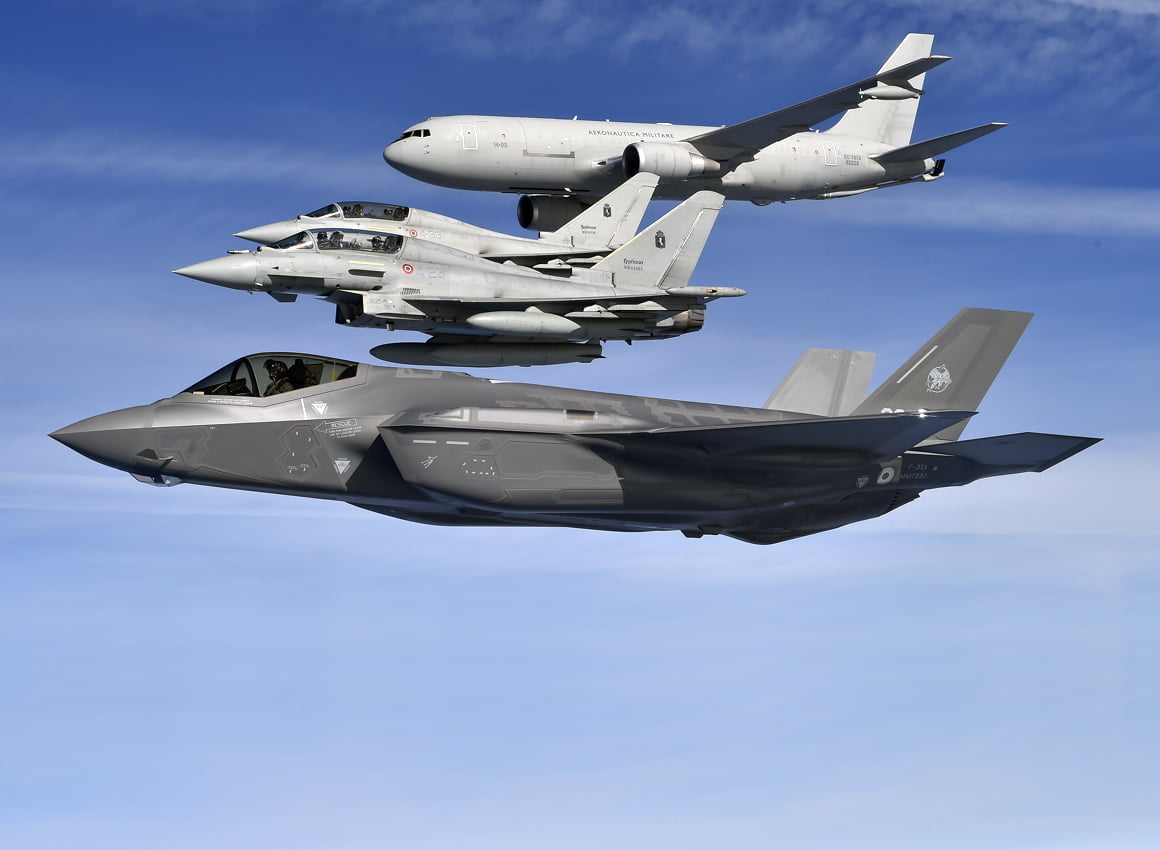2016-05-19 By Robbin Laird
We have argued throughout the discussion of fifth generation aircraft that the transition was about the re-norming of airpower.
It was about reshaping airpower as airpower leads a broader transformation of US and allied combat forces to prevail in 21t century environments and to meet 21st century challenges.
In dealing with a number air forces, it is clear that the process of change is not only underway but accelerating.
And in discussions with the practioners of transformation, it seems clear that a number of key elements of change are underway.
First, the F-35 is more a first generation transformation asset than a phase moving towards 6th, 7th or whatever generation
It is a first generation information dominance aircraft built around distributed C2 operating in a contested environment.
Second, the shift towards developing, buying and working with software upgradeable aircraft means that a key way ahead for airpower is the co-evolution of platforms with one another and with other combat systems on land and at sea.
It will be about the co-evolution of capabilities to shape more effective combat forces.
Third, as a new approach gets put in place, it will affect the way ahead with regard to future procurement of new combat platforms for air, sea or ground operations. As a multi-domain approach evolves for 21st century combat forces co-evolution of platforms becomes central.
In making future platform selections, a key decision point is how they contribute to the ultimate desired effect, and how they contribute to decision-making superiority and enhanced information security and dominance.
In other words, the shift from a platform centric world is not about platforms not mattering; they do; but what is crucial is now evaluating how a new platform contributes in a multi-mission, or multi-tasking and specialized effect for the evolving force.
Recent travels have highlighted the important work, which a number of the forces shaping a transformation approach are conducting.
It is not about some abstract future; it is about the transformation of operational approaches by those forces engaged in defending the interests of the democracies.
Air-Led Transformation: The Australian Case
In Australia, the Royal Australian Air Force is working with other key elements of the Australian Defence Force to shape force transformation. It is an air-led effort, but it is a multi-domain one.
As the Chief of Staff put it with regard to the approach:
“It is like a jig saw puzzle.
You have these really nice pieces to the puzzle sitting in the container, but until you begin to look at the picture your trying to create through the overall puzzle, you do not know which bit goes where.”
With regard to F-35 as an example, Davies argued the following:

“I think Joint Strike Fighter on its own, a fifth generation air combat aircraft, could be regarded as just an air combat aircraft.
If you want to shoot the bad guy down, if you want to defend the battle space for a land maneuver or for a maritime strike, that’s fine.
But what we’re beginning to appreciate now is that it’s not just an air combat asset it is also an ISR node.
If you were to then put two more pieces of your puzzle down and go, “Well that’s starting to form a bit of a picture here,” in the center of your puzzle. ”
What else could I do if it was truly an ISR node?
How do I manage that asset differently than if it was just going to shoot down another fighter?”
Although the puzzle analogy suggested an overall approach what he really was focusing on the interaction between the evolving bigger picture, and relooking at what each piece of the puzzle might be able to do in fitting into a new puzzle big picture so to speak.
“How would you operate the air warfare destroyer differently as you add a Wedgetail, a P-8, a Triton or an F-35 to its operational environment?
And conversely, how could the changes in how the destroyer would operate as you evolve systems on it, affect how you operate or modernize the other pieces of the evolving puzzle?”
The Plan Jericho approach built around a structural change in the RAAF is being accompanied by similar changes in the Army and Navy as well.
Notably, the RAAF has led an effort for a PUBLIC discussion of the transformation approach and has thereby provided insight for interested publics in terms of both the challenges and the strategic direction for the ADF.
Thus, the Australian Defence Minister could not only lead but highlight the approach in PUBLIC as well.
To maximise the capabilities of our current and future Air Force our systems must be networked and integrated to a degree not previously achieved. Air, land and maritime forces need to exploit the high level of connectivity made possible by use of systems uniting them through the space and cyber domains.
Much work has already begun in this regard under Plan Jericho, to which the Chief of Air Force referred, to ensure we have a fully networked joint future force across air, space, electromagnetic and cyber.
With its modernised inventory, Air Force will introduce and develop capabilities that will enhance its ability to work jointly with its sister Forces, in many cases before the systems they will network with enter service with Army and Navy.
The work being undertaken by Air Force now in exploring the “art of the possible” and reducing risk through experimentation and trials means that the benefits of a joint force will be more rapidly realised once the networked systems committed to in the White Paper enter Army and Navy service.
The European Air Group and Air Power Transformation
The European Air Group based at High Wycombe in the United Kingdom has focused upon ways to more effectively integrate a transforming Air Force. This means, on the one hand, how to get better value out of legacy assets, and on the other hand, how best to co-evolve legacy with fifth generation assets.
As Brigadier General de Ponti of the European Air Group put it recently:
“The Eurofighter-Typhoon project is an important effort for our air forces.
It is about the co-evolution of Typhoon with the shaping of a 4th-5th generation integrated force.
It is two prongs of shaping more effective European airpower.
It is a building blocks approach to shaping evolving capabilities.”
The EAG has pioneered as well the effort among the 7 European Air Forces, which are part of the EAG ways to work legacy with fifth generation as the F-35 enters European Air Forces.

Recently, the European Air Group held a working group which continued their work on 4th and 5thgeneration integration, which is viewed, as crucial with 5th generation aircraft here now.
The 2016 two-day 4th 5th Generation Integration Information Forum was held at the home of the EAG, RAF High Wycombe, at the end of April 2016.
With national 5th Generation aircraft programs maturing and the need to integrate 4th and 5th generation aircraft into future coalitions acknowledged the forum is providing a vital conduit to keep information flowing between both EAG nations and external partners and increase the awareness of nations about the challenges to come.
https://sldinfo.com/the-european-air-group-works-4th-and-5th-generation-air-combat-integration/
At the first day of the working session in April, in addition to a discussion of how to think through the co-evolution opportunity and challenge, a number of developments were discussed as well.
First, the emergence of robust machine-to-machine translation technologies had already put into the hands of the warfighter significant capabilities to forge greater capabilities to deploy and operate integrated force packages.
The man-machine revolution is a key part of the way ahead for air-enabled combat power.
Second, fifth generation weapons are emerging which can operate off of both legacy and fifth generation platforms, with different effects and uses, but with the ability to provide a common stockpile of weapons to enhance the sustainable firepower of an integrated fleet.
These weapons are software driven and able to be enhanced further as lessons area learned or the threat evolves alongside their host platforms. Data links allow for cross targeting by different platforms leveraging weapons on other platforms, and capable of much more capable autonomous operations once launched.
Third, lessons learned at recent exercises, including the Trilateral Exercise at Langley last December were discussed as well.
https://sldinfo.com/airpower-in-contested-air-space-highlights-from-the-trilateral-combat-exercise/
NATO Focuses on The Next Steps in Coalition Airpower
One of the take-away lessons from Langley was how targeting and communications are changing under the influence of fifth generation aircraft.
This was a pull exercise in which a fifth generated enabled force was being shaped, in which the core capabilities of the Typhoon and Rafale were being leveraged to shape a more capable air combat force.
The F-22 was ending publically its period of looking like an orphan; and although the F-22 has flown with Typhoon in the past, this was the first time flying with the Rafale.
As Hawk Carlisle put it: “The whole is greater than the sum of the parts and we are working in this exercise in shaping a more effective force.”
The changing threat environment was highlighted by the senior Air Force officers present at the media day event. All of the speakers — USAF Chief Mark Welsh, ACC Commander Hawk Carlisle, USAFE Chief General Frank Gorenc, RAF Chief Sir Andrew Pulford, and General Antoine Crux, Inspector General of the French Armed Forces representing the Chief of Staff of the FrAF – commented on the evolving threat environment, which was perhaps the only topic on which all five provided comments.
The threat environment was largely discussed in terms of contested air space.
The environment is seen as one in which U.S. and allied forces would have an increasingly difficult time to operate to support broader military operations.
The threat was characterized variously as anti-access, area denial, or multi-spectrum threats, or simply adversaries enhancing their capabilities. General Hawk Carlisle put it in terms of a multi-spectrum environment shaping a new threat envelope.
“In this exercise in particular we are focused on enemy aircraft and their missiles, surface to air missiles, and electronic warfare as evolving adversarial threats.”
Carlisle then went on to note that during the exercise “we are focusing on link architecture and communications to pass information, the contributions the different avionics and sensor suites on the three aircraft can contribute to the fight, the ability to switch among missions, notably air-to-air and air-to-ground and how best to support the fight, for it is important to support the planes at the point of attack, not just show up.”
A visit to the NATO Air Power Competence Center highlighted work on how airpower was changing with the operations of fifth generation aircraft and the co-evolution of legacy systems with the augmentation of the role of fifth generation aircraft with the F-35 operating with the Marines and shortly by the USAF.
Broadly speaking, there are two schools of thought among those looking at future generation-enabled air operations.

One school of thought looks at the evolution of networks within which airpower creates its effects and the coming of fifth generation is largely understood in terms of both its impact upon and role within the evolution of networks. This can be seen largely as an update on understanding of network centric warfare in the second decade of the 21st century.
The second school of thought focuses on the evolution of C2 within which fifth generation aircraft provide an impetus to an evolving trend towards decentralized C2.
The difference can be a subtle one but it is a significant one.
The first prioritizes the networks, their operations, and their security and assumes that the hub and spoke system largely continues within which hierarchical decision-making remains a norm.
The second focuses on a honeycomb approach within which force packages are shaped to work with one another but C2 evolves within the battlespace.
Tactical decisions are made at the key point of attack and defense; strategic decision making is really about the decision to deploy a force package, shaping ways for confluence of force to operate and evaluating the impacts of those force packages and calibrating next steps for the deployment of continuous evolving force engagement model.
Although the project is entitled air warfare in a networked environment, the study falls squarely in the second school of thought.
The co-evolution of platforms to shape C2 in self-adjusting networked operational environments is a key element of the approach.
This second focus is at the heart of the JAPCC study.
How will enhanced communication networks working with the co-evolution of new and legacy platforms reshape operations and mission effectiveness?
The study is based on a number of key propositions, which are guiding the research and analysis for the evolution of NATO C2.
“An advanced C2 network through unrestricted communication will permit new forms of information transfer among different platforms that display information from different sensors and employ different weapons
This will happen through:
• Self-synchronization
• In pre-authorised sub-tasks
• Requiring a multi-functional supported-supporting toolbox
The different features or characteristics of these platforms may be combined in real-time to create more effective mission-tailored clusters.”
And this will likely result in an evolution in NATO Air C2 doctrine.
The Director of JAPCC is General Frank Gorenc, USAF. In previous interviews he addressed interoperability through machine-to-machine interaction as part of his future Air Power vision.
Recently, he has clearly identified the significant impact of the coming of the F-35 on NATO airpower.
In an interview with Defense News published on March 16, 2016, General Gorenc identified how he sees the impact of the coming of the F-35:
“The beauty of the F-35 is for the first time ever we have an airplane that literally can do four out of five core competencies. It can do air and space superiority, it can do strike, it can do intelligence, surveillance and reconnaissance (ISR) and it can do command and control.”
With the coming of the F-35 and the evolution of the networks within which coalition airpower operate and are changing, it makes sense to think through a broader approach to C2, notably one which can leverage the evolving man-machine relationship.
The longer-term objective is to have a more effective coalition force which can provide much more effective C2 in a fluid battlespace with maximum effect.
With the evolution of two way data-linked weapons, and of remotely piloted vehicles and the coming of the F-35, the need to both understand and shape a more effective approach to self-synchronization of platforms through a collaborative use of the joint battlespace is crucial.
And understanding how this can be done in accord with the evolution of Alliance or Coalition rules, caveats and missions is required as well.
The JAPCC is taking a solid step forward in looking at the future of airpower and how that future is reshaping concepts of operations.
From Kill Chain to Kill Webs: Expanding the Integrated Fires Solution Approach
The USN is a final example of working operational transformation under the impact of fifth generation capabilities, but seeing them as accelerating efforts already underway.
Some time ago, the Navy put in place its NIFC-CA or Naval Integrated Fire Control—Counter Air battle network solution for enhanced kill chain capabilities.
Now the current head of Naval Air Warfare and the designate to head the Navy’s N-9 Warfare Directorate, Rear Admiral Manazir is leading and effort to think more broadly and to focus on shaping interactive kill webs in an extended battlespace where the blue forces operate as key kill web cells within a honeycombed force.
When we interviewed him late last year, Rear Admiral Manazir discussed the expanded reach and punch of the sea services in the expanded battlepace.
Overall the sea services are expanding their reach, remote sensing and precision strike capabilities. They do so by being networked into an operational honeycomb of interconnected forces with reach, range and lethality against air, sea, space, and land-based targets.
“It is about reach, not range, for the honeycomb-enabled expeditionary strike group,” Manazir said. “The F-35 is a key enabler of this shift, but it is part of an overall effort to operate in the expanded battlespace.”
As the sea services evolve, the decade ahead is not a repeat of the past 15 years. It is not about prolonged ground combat and counterinsurgency. The technology and training exist to insert force to achieve discrete and defined objectives, to maneuver in the extended battlespace, and to work with allies and joint forces to prevail across the full range of military conflict in any part of the globe.
Then during a presentation to the Mitchell Airpower Institute earlier this year, Rear Admiral Manazir introduced the kill web concept within his thinking about the integration of force packages within the integrated battlespace.
His focus on fifth generation was clearly along the lines of the other key players thinking through the force structure evolution NOW and into the future, namely how does fifth generation interact with other key elements to shape a more effective deployed force with distributed but interconnected warfighting capabilities?
Conclusion
The F-35 has arrived at a key juncture in the evolution of 21st century warfighting capabilities.
There is a fundamental OPERATIONAL and TRAINING rethink which is not simply about introducing the F-35 to the force, but it is about the co-evolution of platforms within the force, their weaponization and their connected operations.
And there is a diversity of activity by key players in the transformation process ranging from Australia to the US to Europe to the Middle East back to Europe to the United States and back to Asia.
It is a combat learning dynamic of which the F-35 global enterprise is a key enabler, but in which the F-35 itself will be transformed by the co-evolution of the other key combat assets, the training of the force, and by lessons learned from combat experience folded into the combat learning cycle.
The future is now.



